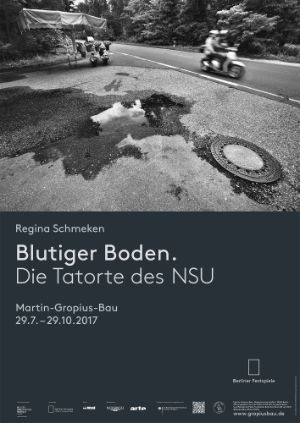Exhibition
Regina Schmeken
Bloody soil. Scenes of NSU crimes

Exhibition poster “Regina Schmeken. Bloody soil. Scenes of NSU crimes”. Image: Enver Şimşek (38) 09.09.2000 Nürnberg Image © Regina Schmeken, 2015
The most oppressive thing about these photographs is that they depict neither the murderers nor their victims. It is their inconspicuousness, the trivial and ordinary that make Schmeken’s pictures so eerie.
Hans Magnus Enzensberger
The National Socialist Underground (NSU) was a far-right terroristic union in Germany. Ten people were killed by members of the NSU between 2000 and 2007 in different german cities – in Rostock, Hamburg, Dortmund, Kassel, Cologne, Heilbronn, Nuremberg and Munich.
The victims were nine men with turkish and greek origin, who lived and worked in Germany, plus one german policewoman. The first victim, florist Enver Şimşek, was murdered on September 9, 2000 in Nuremberg; the last victim, policewoman Michèle Kiesewetter, on April 25, 2007 in Heilbronn. Over 20 people were injured – some of them seriously – by two bomb attacks in Cologne.
On November 4, 2011 the NSU was uncovered. Members of the murdered victims, affected people of/by the bomb attacks and the public firstly found out about the existence of the NSU. The trial of Beate Zschäpe, Ralf Wohlleben and five other allegedly involved people began in 2013 at the Higher Regional Court of Munich. The judgement was 2017 yet to be delivered; the crimes are not yet completely solved.
Regina Schmeken began taking photographs of the NSU crime scenes in early 2013. The victims were found on the ground brutally executed by right-wing terrorists. With her exhibition project “Bloody soil. Scenes of NSU crimes” in the Bundeswehr Museum of Military History in Dresden, she sought to commemorate the victims of the murders and to confront the public with places that, at first sight, seem to bear no traces of acts of violence. Between 2013 and 2016, she paid many visits to the crime scenes. Her journeys resulted in a series of large-format, disturbingly impressive black-and-white pictures.
In the catalogue accompanying the exhibition, Feridun Zaimoğlu (a German author of Turkish origin) calls the history of the NSU a “story of great damage”. German journalist Annette Ramelsberger writes: “The journey to the crime scenes was a journey to a land of pain and tears, of indifference and callousness, and of secret gloating over the things that happened. When the NSU was exposed after ten murders, two bomb attacks and 15 robberies, everybody was convinced that such a series of terrorist attacks could never again happen in Germany. But if you observe the NSU trial, you become aware that there is no guarantee for this.”
The exhibition rose up against the oblivion. It commemorated those who were killed and requested to think about what happened and about the future common life.
Regina Schmeken is taking photographs since the mid-1970s and is one of Germany's internationally acclaimed photographers. Her work is about the perception of reality, its different levels of meaning and their condensation.